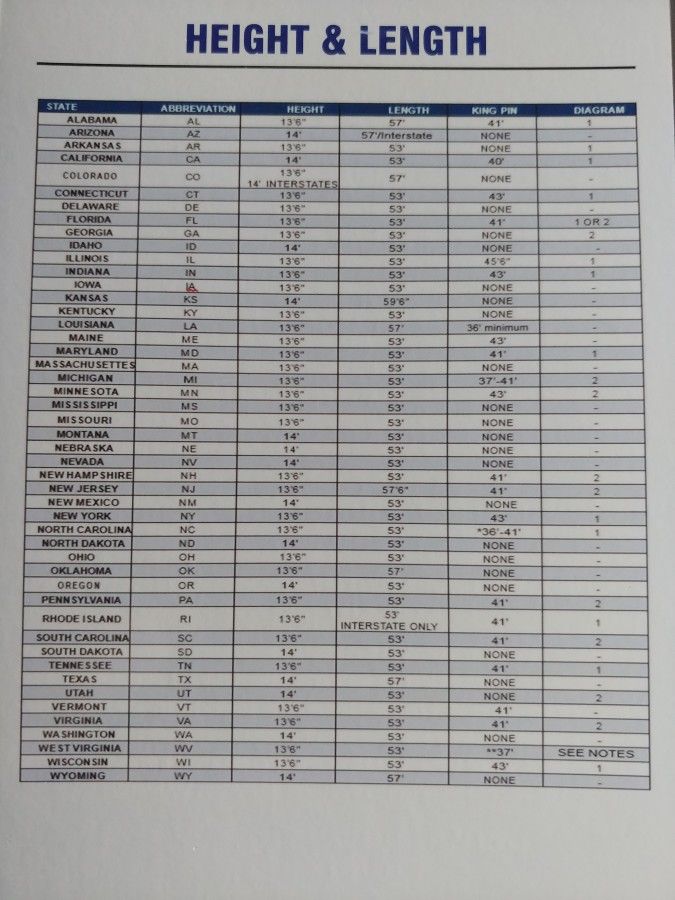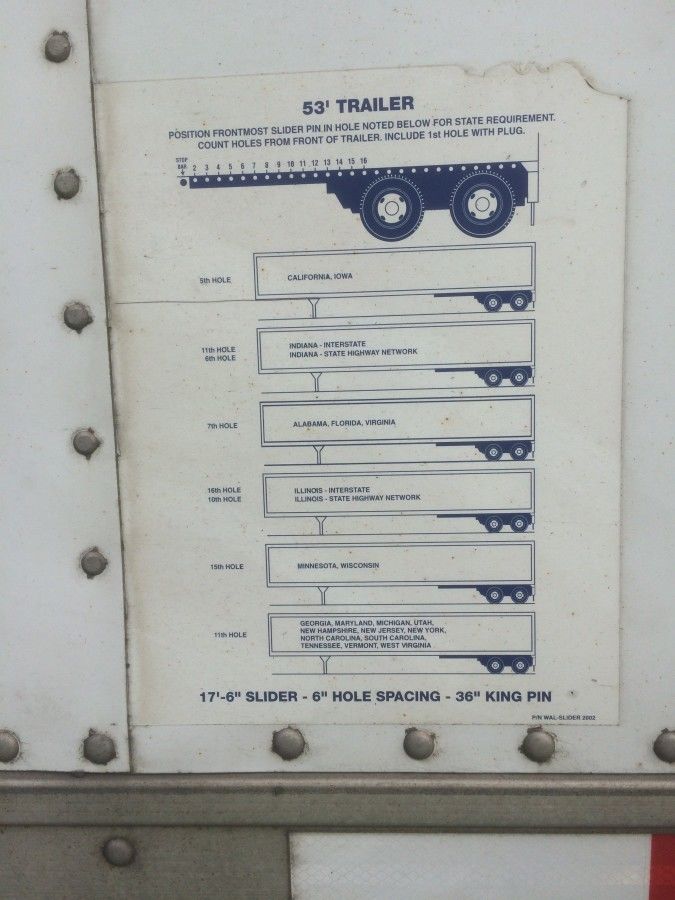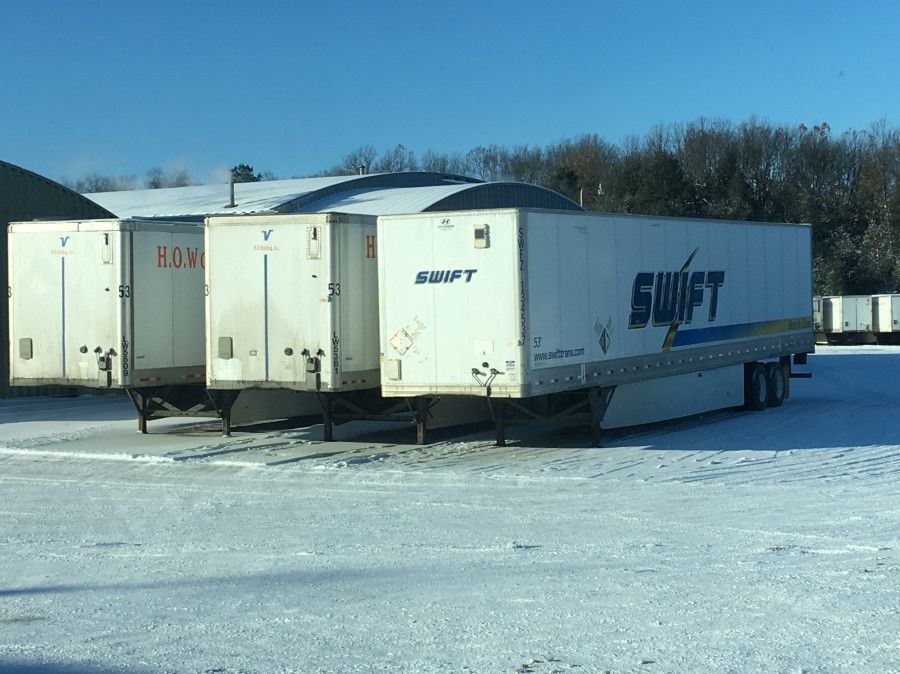Kingpin To Rear Axle Length
Topic 15773 | Page 2
Only Minnesota cares (and not really) about the minimum, is 40' feet from kingpin to the center of rear axle,
Are you really sure about that? In other words, if someone gets a fine for having the tandems too far forward you'll be happy to pay it for them?
I noticed this is your first post here. Welcome! Remember, we're helping brand new drivers get started in this industry so the advice we give is super important and people are going to take it to heart.
Tandems:
Tandem Axles
A set of axles spaced close together, legally defined as more than 40 and less than 96 inches apart by the USDOT. Drivers tend to refer to the tandem axles on their trailer as just "tandems". You might hear a driver say, "I'm 400 pounds overweight on my tandems", referring to his trailer tandems, not his tractor tandems. Tractor tandems are generally just referred to as "drives" which is short for "drive axles".
Tandem:
Tandem Axles
A set of axles spaced close together, legally defined as more than 40 and less than 96 inches apart by the USDOT. Drivers tend to refer to the tandem axles on their trailer as just "tandems". You might hear a driver say, "I'm 400 pounds overweight on my tandems", referring to his trailer tandems, not his tractor tandems. Tractor tandems are generally just referred to as "drives" which is short for "drive axles".
Well in this thread and Maybe others we mention what hole to be in. Not all holes are the same. Some of are trailers are 400 pound holes and others are 250 pound holes. The space between th holes is different. That's why DOT uses a measuring tape and the regs to not mention holes. It is wise to keep a measuring tape on the truck. Get an atlas and the bridge laws and other information is in the front.
DOT:
Department Of Transportation
A department of the federal executive branch responsible for the national highways and for railroad and airline safety. It also manages Amtrak, the national railroad system, and the Coast Guard.
State and Federal DOT Officers are responsible for commercial vehicle enforcement. "The truck police" you could call them.

Well in this thread and Maybe others we mention what hole to be in. Not all holes are the same. Some of are trailers are 400 pound holes and others are 250 pound holes. The space between th holes is different. That's why DOT uses a measuring tape and the regs to not mention holes. It is wise to keep a measuring tape on the truck. Get an atlas and the bridge laws and other information is in the front.
My personal opinion is that counting holes is not the best practice, for exactly the reason you stated. I don't ever count holes. I set my tandems based on the placement of the load if I can look in the trailer, or based on the lifting point if it's pre-loaded, and then go to a scale.
And I see that this is an old topic, but this sorta fits. I ran into another swift driver a few days ago who absolutely swore "the bridge law is only for California".

I wanted to bang my head against the wall after talking to him for 15 seconds. I tried to explain to him why swift has this handy little page in our "Quick Notes" book that lists max kingpin setting for literally every single one of the contiguous 48 states.

And for anyone who has the same question as the OP, notice Louisiana, Michigan, and North Carolina on that page
Tandems:
Tandem Axles
A set of axles spaced close together, legally defined as more than 40 and less than 96 inches apart by the USDOT. Drivers tend to refer to the tandem axles on their trailer as just "tandems". You might hear a driver say, "I'm 400 pounds overweight on my tandems", referring to his trailer tandems, not his tractor tandems. Tractor tandems are generally just referred to as "drives" which is short for "drive axles".
Tandem:
Tandem Axles
A set of axles spaced close together, legally defined as more than 40 and less than 96 inches apart by the USDOT. Drivers tend to refer to the tandem axles on their trailer as just "tandems". You might hear a driver say, "I'm 400 pounds overweight on my tandems", referring to his trailer tandems, not his tractor tandems. Tractor tandems are generally just referred to as "drives" which is short for "drive axles".
DOT:
Department Of Transportation
A department of the federal executive branch responsible for the national highways and for railroad and airline safety. It also manages Amtrak, the national railroad system, and the Coast Guard.
State and Federal DOT Officers are responsible for commercial vehicle enforcement. "The truck police" you could call them.

Alpha wrote:
Only Minnesota cares (and not really) about the minimum, is 40' feet from kingpin to the center of rear axle,
So wrong. Maryland is very strict, the worst. Followed by Connecticut and New Jersey.

I meant to reply to this a while ago, but basically forgot about it...
Chris M wrote:
My personal opinion is that counting holes is not the best practice, for exactly the reason you stated. I don't ever count holes. I set my tandems based on the placement of the load if I can look in the trailer, or based on the lifting point if it's pre-loaded, and then go to a scale.
I don't completely agree with the above approach. When working with pallets of wildly different weights the above process is not going to be accurate or effective.
When you scale, if weight needs to be moved fore or aft you must count holes to ensure accuracy and reduce trial and error "re-weighs" on the scale. There are two trailer slide-rail designs when it comes to hole spacing. Standard hole spacing is one every 6" on-center and represents about 400 pounds of weight, plus or minus for each hole moved. A "micro set" (found on newer trailers) rail has one hole every 4" on-center, representing about 260 pounds, plus or minus for each hole moved. That said without counting holes; how can you accurately and efficiently determine weight balance and/or getting legal? You basically count holes; if you need to get 1600 pounds off your drives to be legal you move your tandems forward 4 holes if the rail is of conventional spacing. If a micro-spaced rail is on the trailer, tandems are moved forward 6 holes. No ambiguity or confusion. It works. I use this technique each and every time I scale a load.
Chris went on to state this:
And I see that this is an old topic, but this sorta fits. I ran into another swift driver a few days ago who absolutely swore "the bridge law is only for California".
I agree the driver you spoke to is definitely wrong, however possibly not for the reason you might think. Technically for a 48' or 53' tandem-axle trailer, the bridge law really doesn't apply or "restrict" in any way due to the spacing minimums mandated by the Law. Based on the length and design of 48' and 53' tandem (twin) axle trailers; it's virtually impossible NOT to be in compliance with Federal Bridge Law because the minimum distance from rear tractor axle and front trailer axle will not fall below the minimum distance restriction. That said, Bridge Laws are not applicable for most of the equipment we use; 53' vans or reefers. For shorter trailers and container chassis less than 48' in length, Bridge Laws definitely govern on minimum axle spacing. Kingpin Law however is definitely applicable and in many eastern states aggressively enforced.
Bridge Laws are Federal; Kingpin to Axle Spacing Laws are State mandated, varied, and although both Laws address weight and axle spacing, they are NOT interchangeable. Don't confuse the two of them. Not every state has Kingpin guidance (refer to Chris' flip chart). The Swift flip chart applies to Kingpin Law and highly relevant for the type of longer dry vans and reefers most of us work with.
Tandems:
Tandem Axles
A set of axles spaced close together, legally defined as more than 40 and less than 96 inches apart by the USDOT. Drivers tend to refer to the tandem axles on their trailer as just "tandems". You might hear a driver say, "I'm 400 pounds overweight on my tandems", referring to his trailer tandems, not his tractor tandems. Tractor tandems are generally just referred to as "drives" which is short for "drive axles".
Tandem:
Tandem Axles
A set of axles spaced close together, legally defined as more than 40 and less than 96 inches apart by the USDOT. Drivers tend to refer to the tandem axles on their trailer as just "tandems". You might hear a driver say, "I'm 400 pounds overweight on my tandems", referring to his trailer tandems, not his tractor tandems. Tractor tandems are generally just referred to as "drives" which is short for "drive axles".
Dry Van:
A trailer or truck that that requires no special attention, such as refrigeration, that hauls regular palletted, boxed, or floor-loaded freight. The most common type of trailer in trucking.Reefer:
A refrigerated trailer.

One final point on counting holes...the below graphic is applied to the driver's side, at approximately the 41' mark of every Walmart reefer and dry van in their fleet. Truth!

Dry Van:
A trailer or truck that that requires no special attention, such as refrigeration, that hauls regular palletted, boxed, or floor-loaded freight. The most common type of trailer in trucking.Reefer:
A refrigerated trailer.

I think I should have been a little more clear on what I was saying. I was referring to counting holes, when it comes to the kingpin laws. Not when adjusting axle weight.
I set my tandems based on the placement of the load if I can look in the trailer, or based on the lifting point if it's pre-loaded, and then go to a scale.
Saying that going to the 17th hole will put you at the 40' mark for California, would only apply to trailers which have the same exact hole spacing. That was why I was saying I don't count holes, when it pertains to kingpin setting.
Tandems:
Tandem Axles
A set of axles spaced close together, legally defined as more than 40 and less than 96 inches apart by the USDOT. Drivers tend to refer to the tandem axles on their trailer as just "tandems". You might hear a driver say, "I'm 400 pounds overweight on my tandems", referring to his trailer tandems, not his tractor tandems. Tractor tandems are generally just referred to as "drives" which is short for "drive axles".
Tandem:
Tandem Axles
A set of axles spaced close together, legally defined as more than 40 and less than 96 inches apart by the USDOT. Drivers tend to refer to the tandem axles on their trailer as just "tandems". You might hear a driver say, "I'm 400 pounds overweight on my tandems", referring to his trailer tandems, not his tractor tandems. Tractor tandems are generally just referred to as "drives" which is short for "drive axles".

Chris replied:
Is think I should have been a little more clear on what I was saying. I was referring to counting holes, when it comes to the kingpin laws. Not when adjusting axle weight.
I agree and thanks for the clarification.
Chris continued:
Saying that going to the 17th hole will put you at the 40' mark for California, would only apply to trailers which have the same exact hole spacing. That was why I was saying I don't count holes, when it pertains to kingpin setting
...and length of the rail comes into play as well, perhaps more so. Contemporary hole spacing configurations are limited to conventional 6" on-center spacing and micro-set 4" on-center spacing. There are only two spacings. Rail length however has far more variety. Great Dane offers numerous standard and special order rail lengths.
The graphic I recently posted in this thread applies to Walmart trailers with 17' 6" rail length on 6" on-center hole spacing (Cali is the 5 hole in this case) only. They also have micro-set spacing graphics on trailers so configured. They use these graphics because they have standardized on the 17' 6" rail. A different way to "skin the cat" in this specific case.
First off sorry for high jacking this thread.
G-Town, I heard a rumor while I was at a Walmart DC in PA last week that Walmart is basically scaling back it's own truck operations to do more contracting out. Have you heard any such stuff?
Oh and you need to come get your trailer out of our yard in Amherst, lol

For some unknown reason lately Swift has been bringing trailers into our yard, which we get loaded and take to Arizona.
New Reply:
New! Check out our help videos for a better understanding of our forum features

















Preview:
This topic has the following tags:
Advice For New Truck Drivers DOT Trailers Truck Equipment Understanding The Laws Weight and Scales







 TT On Facebook
TT On Facebook
Only Minnesota cares (and not really) about the minimum, is 40' feet from kingpin to the center of rear axle,
Tandems:
Tandem Axles
A set of axles spaced close together, legally defined as more than 40 and less than 96 inches apart by the USDOT. Drivers tend to refer to the tandem axles on their trailer as just "tandems". You might hear a driver say, "I'm 400 pounds overweight on my tandems", referring to his trailer tandems, not his tractor tandems. Tractor tandems are generally just referred to as "drives" which is short for "drive axles".
Tandem:
Tandem Axles
A set of axles spaced close together, legally defined as more than 40 and less than 96 inches apart by the USDOT. Drivers tend to refer to the tandem axles on their trailer as just "tandems". You might hear a driver say, "I'm 400 pounds overweight on my tandems", referring to his trailer tandems, not his tractor tandems. Tractor tandems are generally just referred to as "drives" which is short for "drive axles".